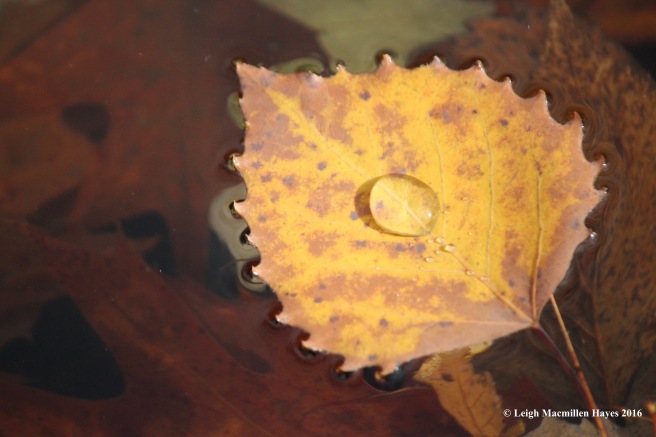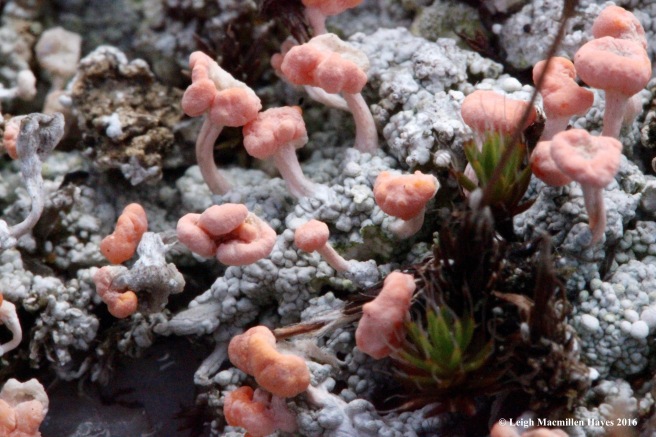When Jinny Mae beckons, I always answer. Oh, maybe not in the affirmative every time, but as often as possible I join her for a forest forage. Ours is not so much to collect anything physically, though sometimes a pinecone or some scat have been known to jump into our packs, but rather to visually and mentally take in all that we see.

Today was the perfect November day for such an adventure. As the breeze blew, the cloud formations kept changing and the sun poked in and out. We were at times chilled and other times warmed–but always happy to be tromping through the woods and across fields in search of great finds.

Sometimes our finds were as simple as raindrops left behind on leaves in the pond.

But a great deal of our time found us on our hands and knees yet again, oohing and aahing among the complex lilliputian world of lichens.

We plopped ourselves down, realizing that no matter where we stepped or sat, we were destroying some form of lichen that was older than time as we understood it. No sooner did we begin to focus when we realized we were beside Rock Foam Lichen (Stereocaulon saxatile).

Perhaps we’ve seen it a million times before, but today we met it for the first time. Its granular surface that speaks to its common name was visible even without a loupe. Though it grew near reindeer lichen, its presentation was different and it was singular rather than colonial. Now, if we can only remember its name the next time we meet–Rock Foam, Rock Foam, Rock Foam.

We are not ones to resist a more familiar friend, and so British Soldiers (Cladonia cristatella) also captured our focus. Despite their diminutive size, those bright crimson caps shouted for recognition.

The thing we reminded ourselves of today is that British Soldiers grow in a branching formation.

In contrast, their cousins, the Lipstick Powderhorns (Cladonia macilenta), sport red caps atop unbranched stalks. Also standing out to the left in this photo are a few Common Powderhorns (Cladonia coniocratea)–recognizable for their lack of a cap.

It seemed we couldn’t get enough of a good thing and as we scooched along the granite surface trying not to destroy too many lichens and mosses, we found a third red-capped variety.

Red-fruited Pixie Cups (Cladonia pleurota) brought smiles to our faces due to their goblet formation topped with those outlandish caps along the margins. We were immersed in Cladonia heaven.

And then . . . and then . . . and then just as our eyes trained on the red caps before us, something else made itself known.

We spied another cousin that I’ve only seen once before: Cladonia cervicornis ssp. verticillate.

Its growth formation is rather unique. In one sense, it reminded me of a sombrero, but in another sense, I saw fountains stacked one atop another, each giving forth life in their own unique fashion. But rather than being called Fountain Lichen, its common name is Ladder Lichen–perhaps referring to the fact that the pixies can easily climb up and up and up again.

One of the lichens that grew abundantly in this place is the Candy Lichen (Icmadophila ericetorum). This one has been long admired for its salmon-colored fruits that rise above the pale grayish-green crustose formation. Today’s realization–that crustose wasn’t as flat as one might expect. In fact, its appearance was rather lumpy and almost brain like.

And beside it, one that I hesitate to name, but will take a stab at anyway–Brown Beret Lichen (Baeomyces rufus). I based my attempt upon a description in Joe Walewski’s book: Lichens of the North Woods. Walewski states: “Crustose pale green to gray green surface with short fruticose stalks topped with a dull brown cap.” I may be totally wrong, but that’s what learning is all about.

We next became equally enthused by the rock shields and their brownish disks.

And living among them–British Soldiers.

While the foliose formation of the shield lichens spread outward in radiating patches, the apothecia that housed spore production sat atop rounded bowls with rolled-in margins. Based on the margins, my guess was that this was Cumberland Rock Shield (Xanthoparmelia cumberlandia). Maybe it was enough knowing it was a rock shield.

And speaking of rocks and shields, while we looked, the surface of the rock moved.

A shield bug, aka a stink bug, crawled along, barely pausing to let us admire the variety of colors it presented.

At last we left the rocks behind and moved on through the woods. Jinny Mae still had a couple more things to show me.

While my camera had a difficult time focusing on the minute fruiting structure of green stain fungi, it had no problem with the Common Stinkhorn (Phallus ravenelii). It’s reportedly the most common stinkhorn in New England, and yet I don’t find anything common about it. As apparent from the “cracked shell” and lack of a stalk yet, this one was just hatching from its embryonic or egg form. We got down to sniff and noted merely a strong mushroomy odor.

With one more wonder to ponder, we returned to Jinny Mae’s home, where she showed me a rotting maple branch decked out in purple.

My first thought because I’d been wearing my lichen eyes–a foliose lichen. But upon further reflection, I think it’s a crust fungi. Whatever it is, again, I’ve never seen it before. But as we noted all day long, once our eyes are focused, things make themselves known.

At last it was time for me to find my way home. My forest forage with Jinny Mae had come to an end for another day, but my mind’s eye is still focused on our wonder-filled finds.

very interesting and beautiful. Ursula >
LikeLiked by 1 person
Thanks Ursula. Lichens are otherworldly and amazing.
LikeLike
These are wonderful photos of the lichens!
LikeLiked by 1 person
Thanks Montucky! It’s definitely a hands and knees experience. 😉
LikeLike